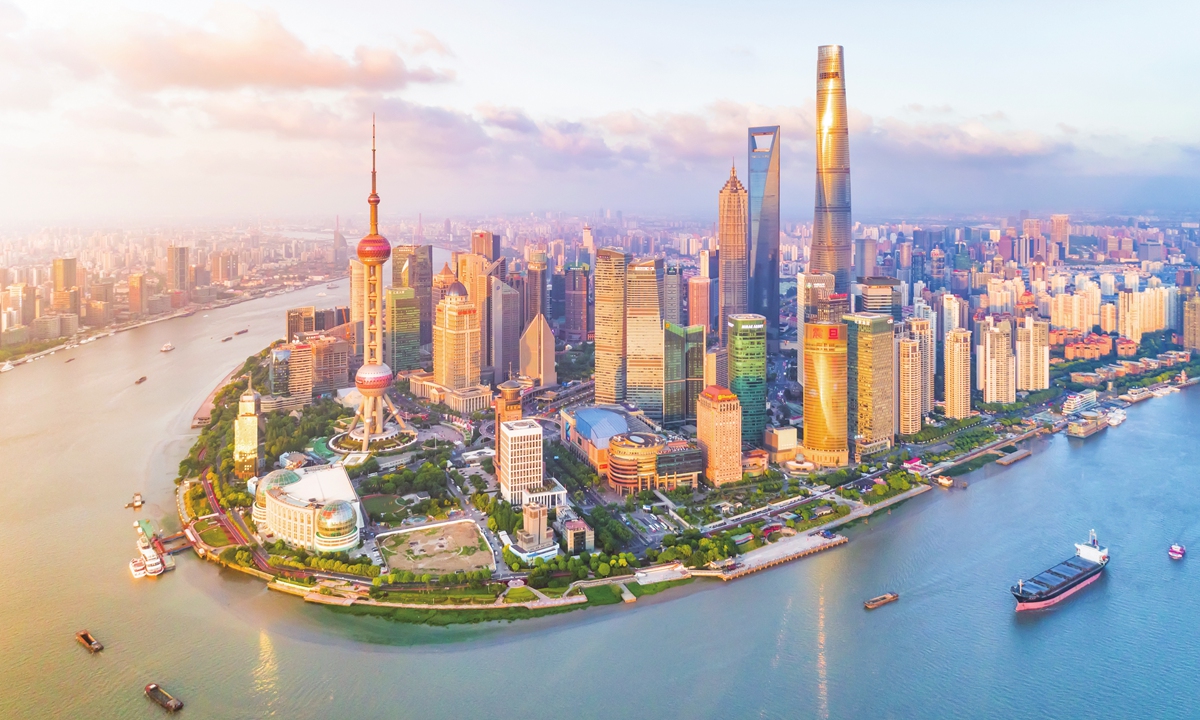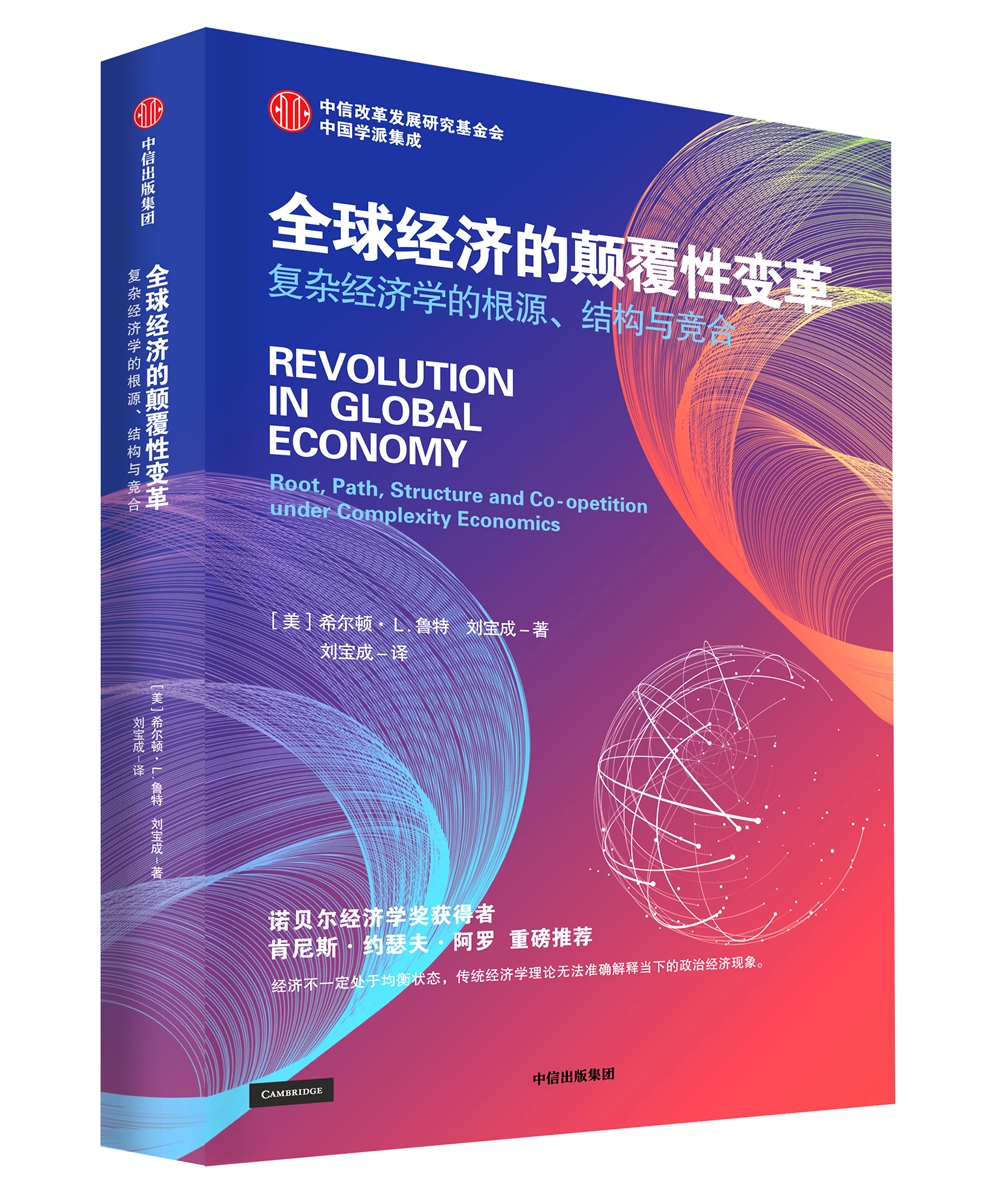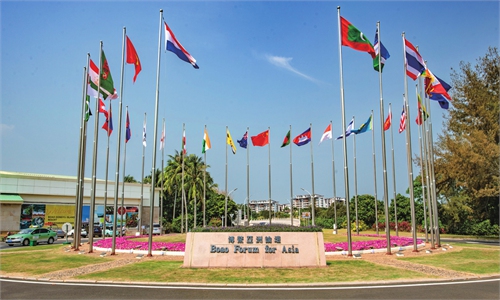
A view of Shanghai Photo: VCG
Editor's Note:
After China optimized its COVID policy and emphasized its opening-up to the world, its economic growth outlook has been in the spotlight of global public opinion. Hilton L. Root (Root), a professor of public policy at George Mason University, who recently published the Chinese version of his book, Network Origins of the Global Economy: East vs. West in a Complex Systems Perspective, told the Global Times (GT) that Chinese modernization is oriented to high-quality growth.
GT: For Chinese readers, what message do you expect to convey through your new book?
Root: We want to improve our mutual understanding by exploring the deep origin of cultural differences. Some of the differences reside in how the two societies balance individual and group selection.
These differences have deep historical antecedents. We look at these deep cultural origins and find that religion is very critical as the deep source of the West's singular cultural unity. Whereas in China, political unification is the source of Chinese cultural identity.
We also want to demonstrate the commonality between China and the US. Although they have different structures and operate according to different rules, they both sustain high levels of complex interaction in both a high degree of cultural evolution and supports cooperation, which you wouldn't find in a stateless society or in societies where the state is either contested or collapsed.
Again, the unity of the Western society comes through the doctrine of the church and its role as manager of cultural evolution. But in China, it comes through the examination system and the unified Confucian curriculum. It created a strong basis for assimilation and enabled the radiation of Chinese culture throughout the empire. One of the differences is that the Confucian system had limited institutional penetration down to the level of local governance, where the magistrates relied on family and placed-based identification and on lineage groups.
By contrast, in Europe, much of the governance capacity resides in civil society groups. A culture of strangers working toward common goals was forged. This means there's much more self-governance and cooperation among these groups. These are some of the patterns that would have a persistent influence on the evolution of the two societies. They all reside in the different network structures of these two societies.
GT: This year, China set a growth target of "around five percent", what's your take about the figure?
Root: Last year was a low base, restoring growth from a low base is not as consequential as maintaining a consistently high level of output. Five percent growth is lower than the last 30 years. But one of the things we must watch is how adaptive China will be to new global trends. The product mix needs to keep the Chinese manufacturing sector afloat is changing radically.
During the pandemic period, there was a great deal of stay-at-home consumption of Chinese-made goods in the US. Now, consumption is shifting back to the service sector. People are not buying the same amount of Chinese-made goods as they did during the pandemic. It will be interesting to see how the Chinese output is adapting to the new demand structure of consumption in the US.
GT: Since China optimized its COVID policies, it has been emphasizing its openness to the world. What do you expect from the reopening of the Chinese economy?
Root: I encourage more investment in China, a lot will depend on convincing potential investors that a reliable rule of law framework has been created, and that there will be a level playing field for all.
GT: How do you understand the "Chinese modernization"? What's its difference from the Western style modernization?
Root:The special characteristic of this modernization drive is the sequencing and the philosophy of Deng Xiaoping of crossing the river by feeling for stones. China tried to tailor its policies to what it considered to be its assets and its initial conditions.
It followed a sequence that deviated from what Western countries were advising. Instead of financial sector reform and privatization first, they started out by strengthening the grassroots with bottom-up reforms in agriculture. In addition to that, they encouraged rural industries. Any collectivities in the town and village enterprises were converted into profit making entities. Some of the profits were recycled into sustaining community, social obligations. Manufactured goods were being traded for machinery. And the government provided extensive support for infrastructure.
There was the dual track system of encouraging private development while the state sector was not completely disassembled. In that way, the sequence of modernization was a more holistic. It included social harmony and governance, and buy-in from local officials. Eventually, it is oriented to high-quality growth.
While China benchmarked its development by what was going on in the West, blended this with its own unique culture, its model deviated from West's vision of global economic integration. Many in the West believed the traditional Chinese system would not survive the vicissitudes of global competition and that Western standards would have to be adopted to avoid wholesale system failure like that of the Soviet Union.
GT: Do you think China's economic development has shown some new characteristics that differ from the past?
Root: Yes. Very much. The integration of Chinese economy followed a very different logic from that of Japan or Korea in the 1960s and 1970s, where industrial restructuring involved transferring entire industries, such as steel and production or shipbuilding.
In the 1980s, when the Chinese economic program of global integration initiated- this was also at the onset of digital capabilities - firms quickly realized that they could break up of production processes and offshore them to locations with the lowest per unit cost of production. The firms that could master these techniques could build or join global value chains. By offshoring they could access massive reserves of financing, and could improve their competitive position vis a vis their rivals. Firms that were not doing business globally would be disadvantaged in their competition with firms that were.
The architects of the Chinese market reforms very clearly saw these global trends, and they adopted their own economic development program to accommodate them. They viewed China's own economic challenges within the larger context of global industrial restructuring. And they focused on integrating China into decisive, transnational production and financial structures. They saw the key players in this stage of globalization to be the multinational corporations, that had originated these vast commodity chains or production networks. They embraced the logic of permitting foreign companies to link their entire global production lines to China as part of their international sales network. The key to the strategy was to enable multinationals to create production links to Chinese partners in the same industries.
This approach was a shortcut to obtain capital and technology. When China nationalized its industrial systems under the protection of state policies, an enormous transfer of technology occurred, as China became increasingly included into these international value chains.
China still needs to create an environment for entrepreneurship that encourages the formation of new capabilities from innovations interconnectivity.
Modernization in China was tailored to the conditions of the global economy in a way that made it possible for the China to quickly integrate into the global value chains. That is the situation that they enjoy today.
GT: Geopolitical risks are intensifying, and the relationship between China and the US is spiraling downward, with the US side hyping up the decoupling with China from time to time. Amid this political environment, what are the strategic directions of American businesses?
Root: There's no substantial evidence in the data of decoupling. Despite the fact that the US has maintained 25 percent tariffs on about half of what the US imports from Chinese, Chinese exports to the US have been increasing.
It's not a trade war, but a chips war. The decoupling is concerned primarily with security issues, and dual-use technologies.
The critical variable concerning future investment by global firms in China is the growth rate in China. And the key players are the multinationals, not so much the US government.
Enhancing the enabling environment for firm creation is critical for attracting further investments. China has opened more sectors to foreign investment in i.e., in banking and electric vehicles. This has been very helpful. But in the capital markets, there remains to be significant opening-up, making available a broader range of complex financial instruments. Financial asset diversification is needed with more emphasis on stocks, insurance and equities and less emphasis on bank lending, which is still the primary financial instrument in China.
GT: How do you think of the collapse of three banks in the US within 7 days, including Silicon Valley Bank? What impact will it have on the global financial system?
Root: The implications of this are being very carefully studied to determine the risks of possible spillover effects and contagion.
The tech sector Silicon Valley sector was facing a liquidity crunch because the interest rate hikes were not built into the calculations of bank managers. They ignored warning signals that higher interest rates were straining their financial model and making repayment more problematic.
Nobody can fully answer this question right now. The hope is that it will prove to be localized in the market for high tech digital startups. But we are far from fully understanding the full extent of possible contamination there are too many variables and possible interconnectivities that have yet to fully reveal themselves. Going forward the Federal Reserve will have to take into consideration that further interest rate hikes may cause more bank failures. They are banking on the belief that tighter lending will put downward pressure on inflation so that continued interest rate hikes might not be necessary. They will be adding balancing financial sector fragility to their equation, something that they haven't really been thinking about prior to last week.
I think the big lesson is that those areas of the financial sector that enjoy the least scrutiny typically end up with the biggest problems. The consequences for the technology sector of rate increases were not being examined from a more global perspective. All of a sudden, in an area in the financial sector that we weren't really thinking about, has become a major concern. Some potential spillovers that could be very troublesome may be waiting for us just around the corner. For now, the priority must be discovering how we arrived at the current predicament.
GT: What do you think is the biggest common interest between China and the US? Do you think there are opportunities for future cooperation between the two sides?
Root: Yes, carbon neutrality, cancer research, nuclear proliferation, research on future global pandemics and global food security issues are among the concerns we share. We have two state-based systems in the world that operate according to different logic. There needs to be a common framework for the smooth resolution of financial crises in developing regions. If they try to create completely separate global supply systems, both are likely to fail.
Many of today's disputes will be superficial in the long run and there are long-term issues need to be addressed cooperatively. Both countries have more to lose by decoupling than they have to gain from it.
I also believe there can be more cooperation in humanities, which are the moral guardians of our culture and values. There's very limited emphasis on cultural exchanges between China and the US in the humanities. At some point, we have to combine science with the humanities and explore the meaning of human existence together. Most of the exchanges have been technological, that doesn't really help us gain deeper mutual understanding. I think we have to avoid tribalism and usher in a new era of the humanities, exploring what is humanly possible between the two countries. This means combining the heuristic and analytical power of science and joining it with the creativity of the humanities.
The problems we face are of an existential nature, the problems of the survival of the planet, the problems of global security, the risk of nuclear war. The problems that we're dealing with right now are of a more transitional character, the process of conflict resolution is going to take us into a very new territory.
We wrote this book because we are very concerned about the deep ethical questions that have risen and are poorly understood. We both have ethical and moral considerations that need to be appreciated simply because there has to be greater cooperation in the future, the alternative would be a disaster for both sides.

Chinese version of the book, Network Origins of the Global Economy: East vs. West in a Complex Systems Perspective, co-authored by Hilton L. Root, a professor of public policy at George Mason University, and Liu Baocheng, director of the Center for International Business Ethics, deputy dean of the Academy of Global Innovation and Governance at the University of International Business and Economics.

